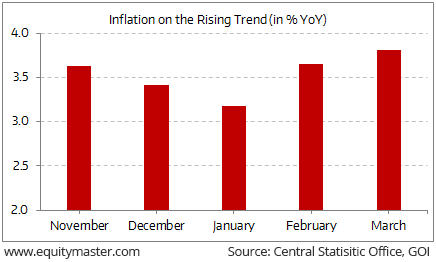India's Third Giant Leap
This Could be One of the Biggest Opportunities for Investors
- Home
- Todays Market
- Indian Stock Market News April 27, 2017
Indian Indices Trade Marginally Lower; IT Stocks Witness Buying Thu, 27 Apr 11:30 am
After opening the day on a flat note, share markets in India continued to trade near the dotted line and are presently trading marginally lower. Sectoral indices are trading on a mixed note with stocks in the consumer durables sector, IT sector, and power sector witnessing maximum buying interest. FMCG sector is trading in the red.
The BSE Sensex is trading down 25 points (down 0.1%) and the NSE Nifty is trading flat. The BSE Mid Cap index is trading up by 0.2%, while the BSE Small Cap index is trading up by 0.1%.
The rupee is trading at 64.09 to the US$. The rupee is witnessing buying interest of late. It presently is hovering near its 20-month high.
The appreciation in the rupee comes as a welcome breather for importers in India. A softer rupee helps importers to buy goods and services at a cheaper rate that earlier. This is vital for a developing economy that relies heavily on imports. So this bodes well for the Indian economy as higher imports normally mean increased economic activity.
Just Released: Multibagger Stocks Guide
(2017 Edition)
In this report, we reveal four proven strategies to picking multibagger stocks.
Well over a million copies of this report have already been claimed over the years.
Go ahead, grab your copy today. It's Free.

But on the other hand, the rise in rupee can spell trouble for exporters. The exporters are at a disadvantage owing to the currency appreciation as this renders their produce expensive in the international markets as compared to other competing nations whose currencies haven't appreciated on a similar scale. This tends to take away a part of the advantage from Indian companies, which they enjoy due to their cost competitiveness.
Nonetheless, a stronger rupee will pull down commodity prices. This will help in keeping a tab on the rising inflation which stood highest in five months in March as can be seen from the chart below:
Retail Inflation Highest in Five Months

While there are advantages as well as disadvantages of a rising rupee, one needs to understand whether the rise in the rupee is sustainable to derive any reasonable conclusion at this stage.
For one, the weakness of the US dollar is largely due to the relative unattractiveness of US assets. This is in part due to a very low interest rate regime prevalent in the US economy. Already there are indications that this low interest rate regime may not be sustainable for long. This means that US interest rates may go up and this may likely strengthen the US dollar.
Moving on to the news from initial public offering (IPO) space... The IPO of S Chand and Company got subscribed 52% on the first day of the bidding process i.e. yesterday.
The IPO received bids for 39,80,174 shares compared with the total issue size of 76,85,284 shares.
The portion set aside for qualified institutional buyers (QIBs) was subscribed to 60% while non-institutional investor quota was subscribed to 23% and the retail quota 60%.
The company has set the price band for the IPO at Rs 660-670 per share and the minimum bid lot at 22 shares. The IPO includes fresh issue of share worth up to Rs 3 billion and an offer for sale (OFS) of 60 lakh shares by the existing shareholders.
S Chand is a leading Indian education content company (in terms of revenue from operations in FY16). The company delivers content, solutions and services across the education lifecycle through its K-12, higher education and early learning segments.
To know our view on this IPO, you can visit our IPO page.
Also, in case you wish to run IPOs through a handy checklist, you can download our Handbook of IPOs.
For information on how to pick stocks that have the potential to deliver big returns, download our special report now!
Read the latest Market Commentary


Equitymaster requests your view! Post a comment on "Indian Indices Trade Marginally Lower; IT Stocks Witness Buying". Click here!
Comments are moderated by Equitymaster, in accordance with the Terms of Use, and may not appear
on this article until they have been reviewed and deemed appropriate for posting.
In the meantime, you may want to share this article with your friends!